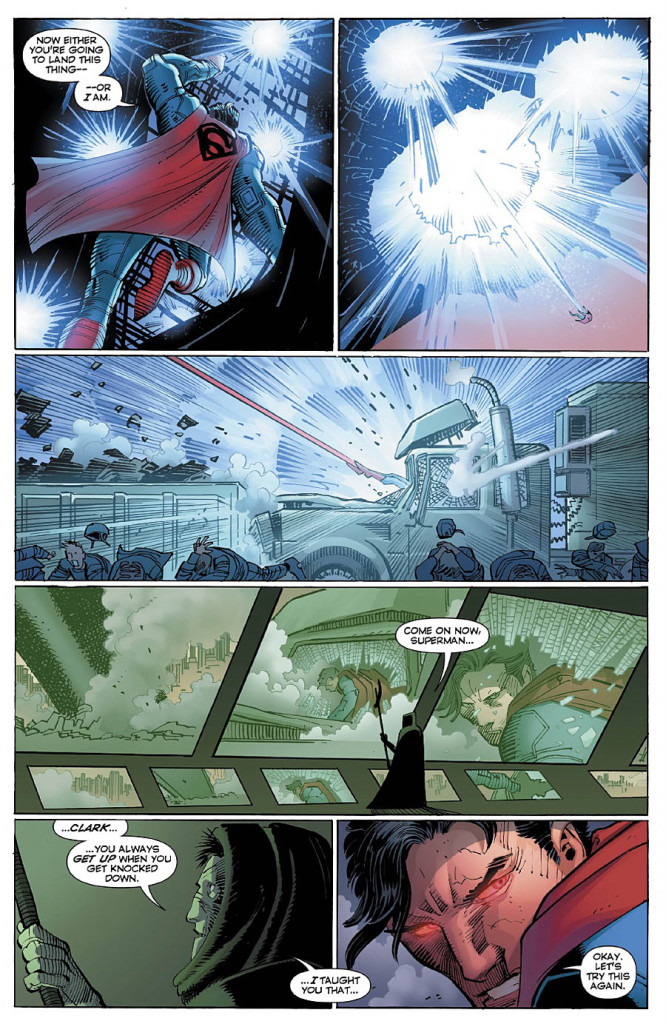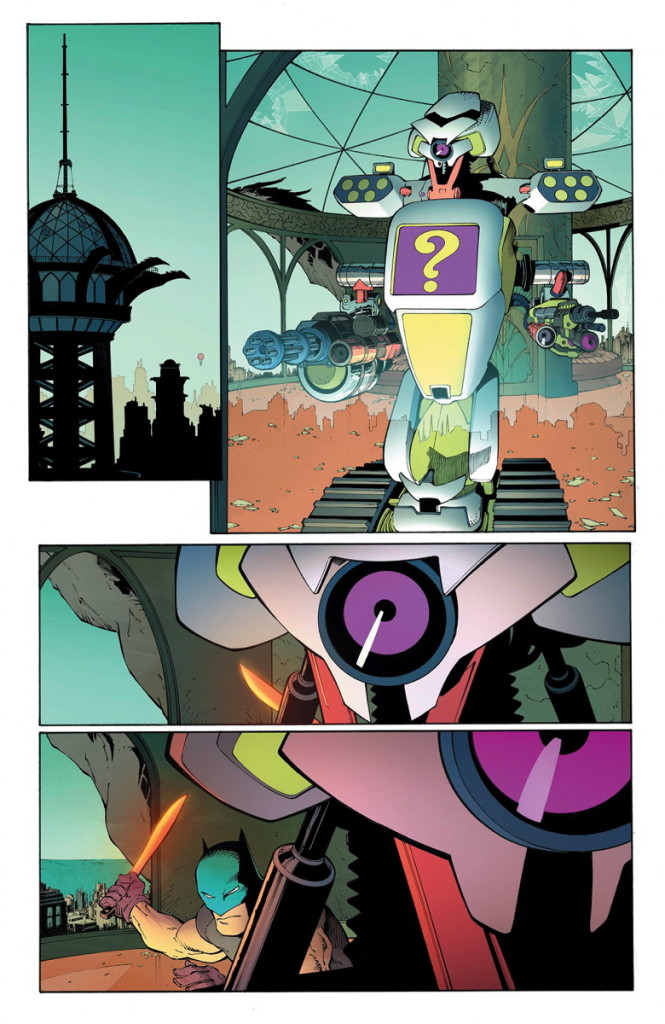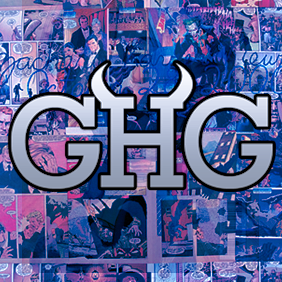![BATMAN vs. SUPERMAN [Sunday Sermon]: Issue #32 – Blessed is the ONE!](http://godhatesgeeks.com/wp-content/uploads/2014/06/rsz_batman-vs-superman-opening-scene-and-lexcorp-details-revealed.jpg)
BATMAN vs. SUPERMAN [Sunday Sermon]: Issue #32 – Blessed is the ONE!
Superman and Batman: the 32nd issues of the titular DC septuagenarian superheros hit the shelves last week, and both are quite the read…
Each issue is a benchmark in the New 52 reboot of the DC Universe. Geoff Johns pens and John Romita Jr. pencils Superman #32, and Scott Snyder and Greg Capullo‘s run on Batman reaches its penultimate chapter; it’s a run that has earned them a nomination for WHAT EXACTLY.
The Superman book has received a lot of hype. Not only because Johns (Green Lantern) is expected to breathe life into the character, who has somewhat languished in his title book, but because it represents Romita’s defection, of sorts, from Marvel Entertainment where he (Amazing Spider-Man, World War Hulk), and his parents have made a name for themselves.
 Snyder, who has also given Super-fans something to enjoy with his much delayed Superman: Unchained mini-series, has had an impeccable run on Batman. He has pushed the caped-crusader to his limits, he’s broken him down to his base, and he made him ditch the cape.
Snyder, who has also given Super-fans something to enjoy with his much delayed Superman: Unchained mini-series, has had an impeccable run on Batman. He has pushed the caped-crusader to his limits, he’s broken him down to his base, and he made him ditch the cape.
Superman and Batman are the world’s finest dichotomy in comics. Both have similar goals but they go about achieving those goals through very different means. (You’re reading this on GodHatesGeeks, so the minutiae of differences don’t need to be explained.) There’s a unique split in the stories themselves.
Johns seems to be charting a course that would make the upside-down world of Superman right again. Clark, who started his own new media company with Cat Grant, is asked by Perry White to return to the Daily Planet. (Thank Rao for that!)
“I need your help, Kent,” White pleads looking at a framed A1 with the a banner headline: Lex Luthor saves the world. “Bad guys are good. Good guys are bad. The world has been turned upside down.”
Lex Luthor’s great villainy is that he can be seen as a hero. This is a relatively new idea. Luthor’s public persona is something that has really evolved since John Byrne’s Man of Steel reboot in 1986. Up to that point, it was just assumed that Luthor is a villain. That is so much the case, there is no attempt at an explanation for Luthor’s dastardliness in Superman: The Movie of 1978. Luthor reemerges as a supervillain post-Crisi in Superman/Batman Vol. 1 first arc: World’s Finest or Public Enemies, by Jeph Loeb and Ed McGuinness. So, the New 52 Luthor has evolved into a complex villain. Those very first panels between White and Kent are setting up the fight that is to come. Johns is definitely setting up THE Superman confrontation where Lex Luthor returns as a villain.
But the Superman mythology is also more immediately re-established, White’s character reintroduces the reader to Jimmy Olsen as a somewhat hopeless hanger-on. He reaffirms Clark’s seemingly empty and lonely life. Readers have been presented with a well adjusted Clark Kent/Superman in the New 52, but there are cracks there, and Johns will exploit them.
Snyder, on the other hand, has torn Batman’s world apart.
So, everything you thought you knew about Bruce Wayne’s crusade is basically wrong. But that’s just window dressing. In Zero Year (likely homages to Year One and Zero Hour), which is set six years in the past we are introduced to a Bruce Wayne with no money, no company, and no cape. Gotham has been cut-off a la Dark Knight Rises and is threatened with annihilation by … the Riddler?
The Riddler is a character that embodies the worst of campy Batman. He’s a gimmick supervillain, and the name alone either envokes images of the 1968 Batman television series, or Joel Schumachers disastrous Batman: Forever and Jim Carrey’s over-the-top portrayal of the character. The Riddler as mastermind, and as Batman’s first adversary works, and that’s something that would not be possible without Jeph Loeb (see the pattern) and Jim Lee’s Hush storyline.
There is an understanding of Batman in issue #32 that seems to have been driving Snyder’s work for his entire run on the series. Batman knows that he has failed. He believes he has lost. He thinks he is going to die, and in recording to Alfred he explains this.
“I have failed against the Riddler, Alfred. And I’ll probably fail again now,” Batman says. “Maybe that’s what the Batman is about. Not winning, but failing, and getting back up. Knowing he’ll fail, fail a thousand times, but still won’t give up.”
The writing is juxtaposed with Batman walking alone in the destroyed Gotham City. Unlike Johns who seems to be reassembling broken parts of Superman, setting wrongs right, and coalescing the myriad interpretations of characters like Luthor, Snyder is presenting an entirely new vision of Batman. Frank Miller’ s Year One defined so much of what Batman used to be. By the very nature of the arc’s title, Snyder has erased what Batman was. Going forward, Snyder’s Zero Year is the new Batman cannon.
“Silence” is used to great effect in Batman. Snyder knows when not to write and he let’s the panels, penciled by Capullo (Spawn), tell the story. It’s a great trend that has made its way through many books. The “silent” panel (is there and industry word for that?) is also used well in Superman, too. But in Batman, they add a real sense of drama. It’s usually by allowing Batman to do Batman things like fight a robot, or jump out a window, or stand menacingly in front of a replica Sphinx. Those panels give depth to the story, and words too often can ruin the pace of a graphic story. The blend is pitch perfect in Batman.
In otherwise fantastic pair of reads, there’s just one problem: Ulysses. One of the tropes in Superman stories is the alternative-Superman storyline: a character with powers and abilities far beyond those of mortal men is introduced. For a time, that character supplants Superman in the minds of the public. Think: Steel, Eradicator, Cyborg Superman and Superboy in Reign of the Superman, or Mr. Majestic of Wildstorm in the Strange Visitor arc, and Mon-El in New Krypton. The juxtaposition between one hero and the other is supposed to show the reader what makes Superman, Superman. The Superman readers don’t need it so soon after another trope of my-own-worst-enemy stories in Doomed, and Snyder’s own Superman juxtaposition, Wraith, in Unchained.







![DYING LIGHT [Preview]: Walk Among the Living, Run Among the Dead.](http://godhatesgeeks.com/wp-content/uploads/2014/12/281093-DYING-LIGHT-220x180.jpg)
![EXODUS – GODS and KINGS [Face-Off Review]: Moses’ Creed X.](http://godhatesgeeks.com/wp-content/uploads/2014/12/exodus-gods-kings-christian-bale-220x180.jpg)
![STAR WARS: THE FORCE AWAKENS [Trailer Review]: Lightsabers are like Perfect…](http://godhatesgeeks.com/wp-content/uploads/2014/12/10406939_10204474019186011_5094508098426370472_n-220x180.jpg)
